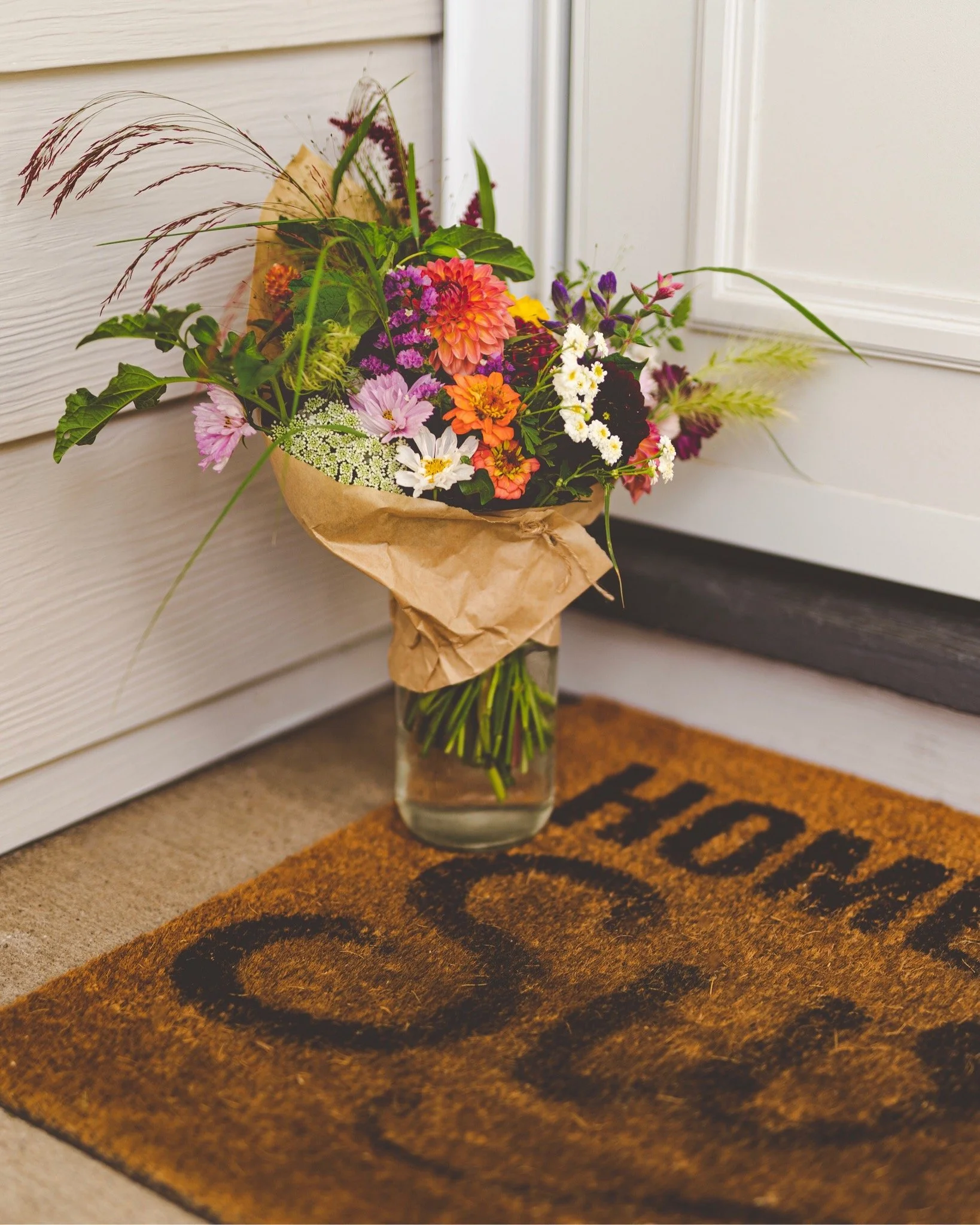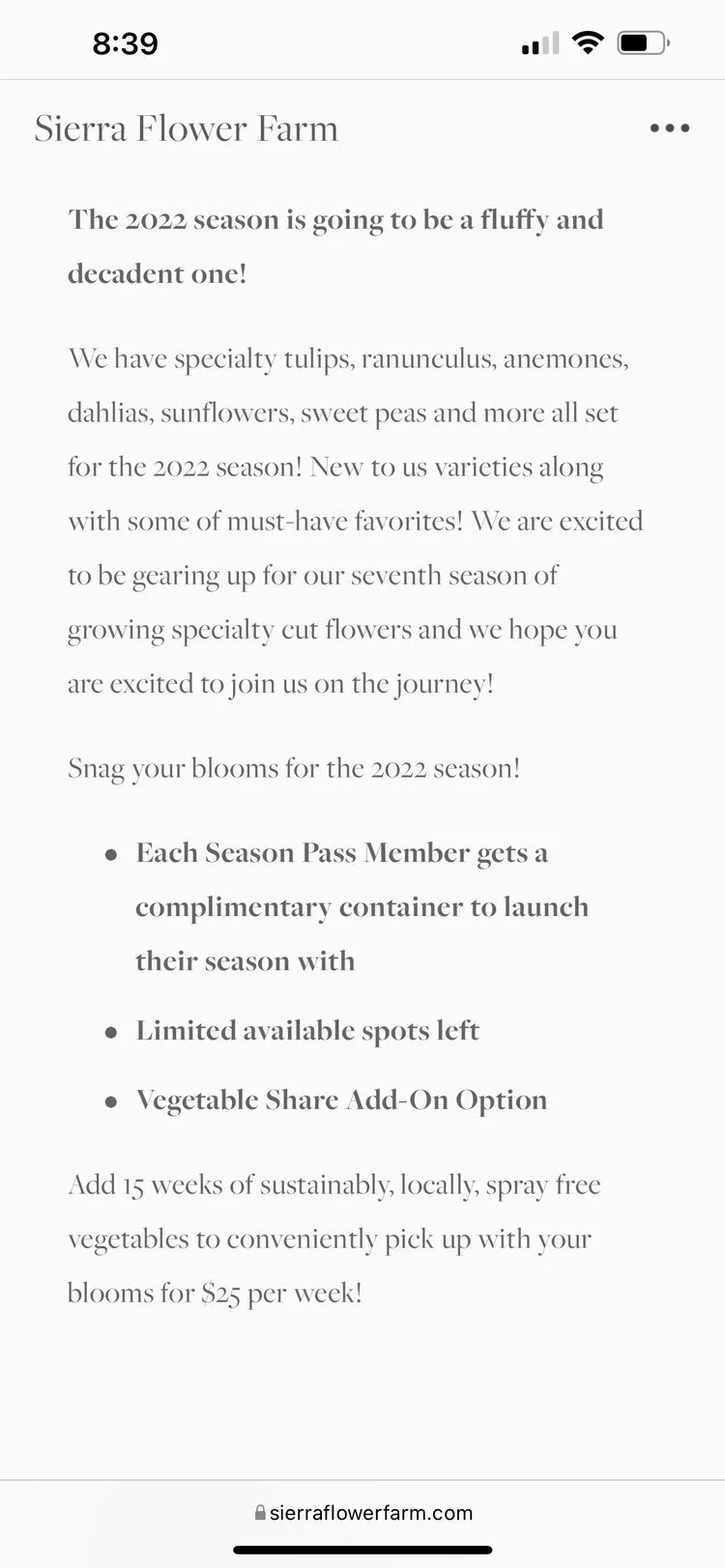Building a Bouquet Subscription Program for Your Farm
Bouquet Subscriptions. Flower Shares. Flower CSA. Flower Subscription.
There are so many names for this product!
You might be wondering things like: What exactly is a bouquet subscription? Will I have enough blooms to fill pre-orders? Why even take pre-orders in the first place? How do I start or sell a subscription, especially as a new flower farmer? Is it profitable, and is it unique enough with its rising popularity? What does it take to execute a successful bouquet subscription?
These are all valid questions—and I’m sure you have more! Today, let’s dive into what makes bouquet subscriptions a valuable offering, the pros and cons for your business, and the nitty-gritty details on how to sell and execute this product successfully.
Why We Chose the Bouquet Subscription Route…
Over seven years ago, when I first began envisioning Sierra Flower Farm, I researched different sales models to see what would best align with my goals—just as you might be doing now. With only 1,500 square feet of growing space, maximizing my price per stem was essential, which ruled out wholesale from the start. Direct-to-consumer sales felt like the right fit.
As a stay-at-home mom with two toddlers, I needed something manageable and flexible. Selling from home wasn’t ideal, given our small space, my need for privacy, and, honestly, my hesitance over the tiny size of my plot back then.
Initially, I thought this would be a small side hustle—a little flower garden. But I quickly realized I wanted to grow far more varieties than a few customers could support. Even on a small scale, I ended up producing more than I could sell at the market, and I faced premium prices for supplies without bulk discounts.
I also didn’t expect Sierra Flower Farm to feel like a third child or anticipate the high demand for locally grown flowers. There was a clear gap in our community for fresh blooms, and soon, opportunities opened up. We became vendors at a local pop-up shop and were invited to a farmers’ market forty minutes away. Yet, I didn’t want to give up my dream of delivering flowers and involving my girls in the business. From the start, it was essential to me that they experience the process, learning about hard work and the lifestyle of flower farming.
That’s what led me to the CSA concept.
What is a CSA?
You likely know what a “CSA” is, but just in case, let’s dive in a bit.
In this context, “CSA” stands for “Community Supported Agriculture.” It’s a common sales model for market growers where customers pay upfront, sometimes months in advance, to receive a “share” of the harvest. Traditionally used for vegetables, dairy, or meat, CSAs now often include flowers, either on their own or paired with other products.
Seven years ago, a few pioneering flower farmers were exploring this model, but it wasn’t common in our area. My own experience with CSAs came from friends who offered a “Bountiful Basket” of vegetables and local goodies, which Graham and I occasionally received when his parents were away. Each week, opening those baskets filled with fresh produce and recipes felt like a treat and a break from grocery store routines. I wanted to recreate that same feeling—but with flowers.
In the early years, we sold at farmers’ markets and pop-up shops, which helped build connections and create memories, but I knew these were temporary outlets. My goal was to build a flower CSA that provided flexibility, guaranteed sales, repeat customers, and a product that could grow alongside us season by season.
The Pros and Cons of Bouquet Subscriptions
Pros:
Committed, Repeat Customers: A subscription model creates a base of loyal, repeat customers who value and trust your work. Serving these members regularly is more efficient than chasing one-off sales, and many of our members have been with us for years, bringing in new customers through word-of-mouth.
Improved Design Skills: Weekly bouquet-making offers hands-on experience with floral design, enhancing skills valuable for both subscriptions and events.
Easily Integrates with Other Offerings: Bouquet subscriptions work well alongside other sales outlets, like weddings, markets, or wholesale orders. Early-week subscription sales free up weekends for events, allowing us to maximize harvests.
Cons:
Potential for Misfit Customers: Not every subscriber fully understands what they’re signing up for. Occasionally, it’s necessary to assess whether the subscription is a good fit for them and decide on a solution with patience and professionalism.
Liabilities of Pre-Sales: Taking payment upfront can be a stressor, especially with risks like crop loss. Setting clear terms helps manage these expectations and creates a smoother experience for everyone involved.
Customizing a Bouquet Subscription that Works for You
As with all flower farming, bouquet subscriptions aren’t one-size-fits-all. Over the years, we’ve refined our subscription offerings to suit our needs, moving from seasonal options to a full-season pass that runs for 24 weeks. Revisiting your subscription model each season, just like you review crop notes, helps ensure your offerings align with your goals and customer needs.
When customizing your subscription, consider these key questions:
What are your strengths and interests? Whether you love floral design, are great at producing volume, or prefer DIY arrangements, tailor your offerings to match.
What’s your desired season length and frequency? Start with a structure that feels manageable. You could offer weekly, bi-weekly, or monthly subscriptions, or limit it to peak season months. In the early days, we found bi-weekly scheduling with “A” and “B” weeks was a good balance.
What specific structure suits your business? From the number of members you can handle to pickup/delivery logistics, consider how you want the subscription to function day-to-day. Determine pricing, product offerings, and whether you want to add unique options like a vegetable share.
Over the years, we’ve offered various subscription formats, starting with seasonal puns like “SPRINGing for Flowers” and eventually evolving to a 24-week Bouquet Season Pass. Our subscription season now typically spans mid-April through late September, adjusting as needed based on frost timing and bloom availability. At the end of the season, some of our members even opt for week-by-week bouquets.
Remember, a subscription is one of the most customizable products a flower farmer can offer. Each season presents new challenges, but by setting a structure that reflects your strengths and goals, you’ll be well-equipped to handle surprises along the way.
Key Elements to Decide On:
Length of the subscription season
Frequency of deliveries/pickups
Number of members you can handle
Pickup or delivery logistics
Product details (arrangements, DIY buckets, etc.)
Pricing
How to market subscriptions, especially for new growers
Packaging and transportation needs
Communication with members
Every season brings unique lessons, especially when working with a natural product and real people. Let’s dive into how to set up, market, and manage your subscription effectively!
Selling Bouquet Subscriptions... Before You Have Flowers
Since bouquet subscriptions are pre-sales, selling without blooms (especially in your first year) can be challenging. Some growers suggest waiting until year two to start a subscription, arguing that a solid first impression with quality, consistent blooms helps build a loyal customer base. While this advice has merit, I'm here to cheer you on if you feel ready to tackle a subscription in year one!
How to Sell Without Bloom Photos
For your first season, focus on selling yourself and your journey. Capture photos of seed sowing, seedlings, and your field prep—it’s a way to build a personal connection with potential customers. If you prefer, show pictures of the specific varieties you’ll be growing (with permission from suppliers if needed) or even create a hand-drawn or watercolored bouquet to represent your future offerings. Avoid stock photos; authenticity goes a long way. Sharing your journey through blogging, vlogging, or even quick reels can build trust and anticipation.
How Many Members to Take On
Choose a manageable number based on your capacity. For us, close to forty members was the upper limit, especially with other commitments. Consider starting small—you can always add spots in future seasons. And remember, the most important thing is to stay within your limits to deliver quality service.
How Much to Grow for Your Bouquet Subscriptions
There’s no exact answer here, as growing needs vary widely based on climate, soil, cultivar selections, bouquet recipes, and whether you have established perennials to supplement.
A conservative approach is to plan for about one stem per plant per harvest, or around 2-3 stems per week per plant. This is a very basic estimate, especially if you're focusing on one-time cut varieties. For more detailed planning, check out our related blogs (linked below) or join our Flower Farming Newsletter to download our free master crop plan workbook:
Selling Bouquet Subscriptions
When selling subscriptions, aim to make the process enticing, smooth, and enjoyable for your customers.
Currently, we use our website and email campaigns to reach subscribers, and in the early days, we also promoted our subscriptions at farmers’ markets and pop-ups. Even today, we occasionally have customers sign up in person at community events, which can be invaluable for early-stage engagement.
Offering flexible payment options like ApplePay, PayPal, and Stripe on our website has made transactions convenient. While we also take payments through Square and in person, routing purchases through the website helps with order tracking. There’s nothing like waking up to sales that happened overnight!
Pretty flower photos certainly help sell subscriptions, but pairing them with a vivid description of your offerings lets customers envision their bouquets. On our site, customers can easily select pickup locations, packages, and any add-ons.
Gathering Key Information at Signup
At signup, be sure to collect key information from your members. Since many subscriptions are purchased as gifts, you’ll need contact details for the recipient—not just the cardholder. It’s also helpful to gather both billing and delivery addresses, especially for home deliveries, as they’re not always the same. During the pandemic, for example, having accurate delivery information allowed us to provide no-contact delivery for quarantined members.
Consider adding a field for special notes or instructions, like scent sensitivities, to personalize their experience. Finally, include a section for terms and conditions, requiring acknowledgment before checkout. This not only sets clear expectations but can also be valuable in handling any chargebacks.
Keeping the subscription process smooth, easy, and efficient establishes a positive first impression and sets the tone for a great customer experience.
Managing Your Bouquet Subscription Workflow and Pricing
What Should Your Bouquets Look Like?
When planning your bouquets, consider the following:
Style and Size: Decide on a consistent look and size that balances fullness with value. We keep ours fluffy and reasonably priced.
Seasonal Variation: Early spring bouquets are often more delicate, while summer bouquets become fuller as more blooms are available. Adjust stem counts to maintain visual appeal throughout the season.
Design for Small-Scale Farms: Without the volume of larger growers, focus on design quality. Starting the season with a vase arrangement can add value and create a memorable experience.
Balancing Value and Price: Spring bouquets may require more stems to look full, which is why many farms price spring subscriptions higher. For us, this initial investment helps build loyalty with our customers.
Creating beautiful bouquets with a unique presentation helps small farms stand out, even if we can’t compete with mass producers on price alone.
My Workflow from Harvest to Assembly
The day before or the morning of harvest, I create a bouquet recipe and calculate the required stems for each order. Once the list is set, the team and I begin harvesting early, ensuring we’re finished before pollinators arrive.
Harvested stems go into clean buckets with CVBN tablets to extend freshness, and we keep the buckets in the shade before moving them into a cooler to condition for at least three hours (preferably overnight). Cooling the flowers immediately is crucial for quality.
On assembly day, we arrange the stems in order, then two team members create bouquets while one wraps, adds flower food, and labels the buckets by pickup location.
On delivery day, we load up the bouquets, send a text to members upon delivery, and let them know their flowers are waiting!
Deciding on a Price Point
Pricing can vary widely based on your local market. In some areas, $20 bouquets may be the maximum while other markets can support $50 or more. It’s essential to match your bouquet’s value with its price point: use affordable varieties like sunflowers instead of dahlias for lower-priced bouquets, and skip luxury varieties unless your market can support it.
To determine a price point, account for expenses like sales tax, delivery, labor, packaging, and flower food. With rising costs, such as gas prices, ensure your subscription remains profitable. Inflation can be an advantage if customers commit early at a set price.
I’ve seen subscriptions range from $15 to $65 per bouquet; we aim for a middle ground. Decide how casual or luxurious you want your bouquets to be and consider what your target customer can afford.
Offering Discounts for Subscribers
Consider offering a small discount to subscription members who pay upfront, as a thank-you for their early commitment. For example, our bouquet subscriptions are priced slightly lower than similar bouquets sold at pop-ups. Recognize that pre-payment is a sign of trust, and offering a discount can show appreciation.
On-Site Pickup, Pickup Locations, or Home Delivery?
Choose the best way to get bouquets to your members based on what’s manageable for you.
On-Site Pickup: Convenient but may blur work and personal space. If hosting at home, set pickup windows to maintain boundaries.
Pickup Locations: Partnering with local businesses as pickup locations can be a win-win. Our locations include a golf course clubhouse, vintage shop, art studio, and accounting office. These partnerships allow us to give back with seasonal gifts and build community support. Don’t hesitate to reach out—many businesses love the chance to host weekly flower pickups!
With your logistics set, you’re ready to finalize the details for a successful bouquet subscription experience.
The Business Side of Bouquet Subscriptions
Welcome and Educate
A strong welcome and clear information set the stage for a smooth subscription experience. We encourage members to review our FAQs before signing up and require them to accept our terms, including final sales policies, to avoid misunderstandings. Close to the season’s start, we send a welcome email with care tips, pickup site details, FAQs, terms, and a friendly introduction to their flower journey. This email also encourages them to inform us of vacation dates, allowing us to coordinate pickups and set expectations.
Keeping Track of Members
While some growers adopt a strict “no pickup, no flowers” policy, we aim to accommodate within reason. For planned absences, members can arrange for a friend to pick up their bouquet, or we’ll donate it. We replace missed pickups once as a courtesy; after that, we leave it to the hosting business to distribute.
To manage this process, I use a customized spreadsheet in my season’s workbook. It tracks each member’s contact details, pickup location, package choice, and any updates they provide throughout the season. For pickups, I log each delivery by week and add notes for absences, using asterisks to confirm completed deliveries. This system keeps us organized and helps ensure no bouquets are missed.
Pickup Day, Transportation, & Delivery of Flowers
To balance weddings and subscriptions, we’ve carefully planned our schedule, with subscriptions ready for pickup on Wednesdays. This timing allows us to focus on weddings later in the week and make Sundays a family day. Sharing this approach can help you think through how to align your own schedule.
For pickups, we use a checklist for each location—one for us and one left with the flowers—to ensure everyone receives the correct bouquet. This system is helpful, especially when members have varying schedules or make last-minute changes.
Transportation and Containers: We transport flowers in buckets for easier storage at pickup sites. Initially, we delivered flowers in jars or milk crates, but as subscriptions grew, we found buckets more efficient. For a special touch, we provide members with a reusable vase on their first delivery, which they can use all season long. Compostable cups are also on hand for anyone who forgets their container. If budget allows, eco-friendly wraps like EcoFresh are a great option.
Communication is Key
Clear communication is essential for a smooth experience. We keep members informed of any crop issues or schedule changes, and in return, we encourage them to let us know about any concerns. This two-way communication builds trust and allows us to address any issues quickly, strengthening the relationship.
Adding a Personal Touch
In today’s digital world, personal connections set us apart. We like to remind our members that we are their farmers and that we appreciate their support. To add a personal touch, we include handwritten cards at the start and end of the season, making sure they know they’re part of our story. These cards are more than just notes—they’re a way to show that we value each member.
We made it to the end—yay!
The aim of this post was to provide a "buffet" of ideas and insights for creating a bouquet subscription, whether you’re just starting out or expanding your flower farming business. If a direct-to-consumer bouquet subscription feels like a good fit for you, I hope these tips help guide your approach.
For more inspiration, be sure to check out our related blog on the evolution of our bouquet subscription, where we delve deeper into our own “why’s” and “how’s” over the years.
Happy planning, and here’s to building beautiful connections with your community!
We are looking forward to sharing more blooms with you soon.
Jessica & Graham












